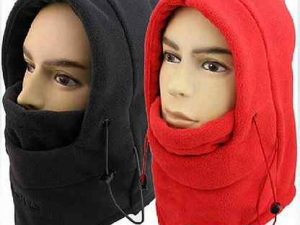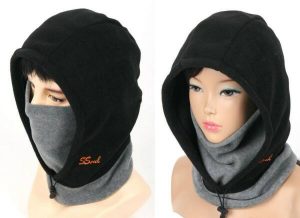A face cover outdoor warmer set is a collection of cold weather gear that is designed to keep the face and neck warm and protected during outdoor activities. It typically includes a variety of items such as a face mask, neck gaiter, and hat with a face cover.
The face mask in a face cover outdoor warmer set is designed to cover the lower half of the face, including the nose and mouth. It may be made from a warm and insulating material such as fleece or wool, and is typically adjustable to ensure a comfortable and secure fit.
The neck gaiter in a face cover outdoor warmer set is a tube-shaped piece of fabric that is worn around the neck and can be pulled up over the face as needed. It is also typically made from a warm and insulating material, and provides additional coverage and protection from the cold.
The hat with a face cover in a face cover outdoor warmer set is designed to cover the head, ears, and lower face. It is typically made from a warm and insulating material, and may include features such as ear flaps or a built-in face cover.
Overall, a face cover outdoor warmer set is an excellent choice for anyone who spends time outdoors in the winter, particularly during activities such as skiing, snowboarding, or hiking. It provides comprehensive coverage and insulation, helping to protect against the cold and wind and keeping you warm and comfortable during your outdoor adventures.
Types
There are several types of face insulation that can be used to keep you warm and protected from the cold when you are outdoors:
- Balaclava: This is a full-face mask that covers the entire head and neck, except for the eyes. It is typically made from a combination of wool, synthetic fabrics, and sometimes even neoprene, which provides excellent insulation against the wind and cold.
- Neck gaiter: A neck gaiter is a tube-shaped piece of fabric that can be pulled up over the face and neck to provide insulation. It is lightweight and compact, making it easy to carry in a backpack or pocket.
- Scarf: A scarf can be wrapped around the face and neck to provide insulation. It is typically made from wool, cashmere, or other warm fabrics, and can be a stylish accessory as well as a practical one.
- Face mask: A face mask is a lightweight and breathable option that covers the nose and mouth, providing insulation without being too heavy or cumbersome. Many face masks are made from materials that wick moisture away from the skin, which helps to prevent chapping and other cold-related skin conditions.
- Hat: A hat can also provide insulation for the face, particularly if it has a brim or ear flaps to cover the cheeks and chin. Wool and fleece are popular materials for cold weather hats, as they provide excellent warmth and wind protection.

Balaclava:
A balaclava is an essential element of an outdoor face insulation kit, particularly in cold and windy conditions. It covers the entire head and neck, except for the eyes, and provides excellent insulation against the cold. Balaclavas are typically made from a combination of wool, synthetic fabrics, and sometimes even neoprene, which provide excellent warmth and wind protection.
When choosing a balaclava for your outdoor face insulation kit, consider the following factors:
- Material: Look for a balaclava made from high-quality materials that will keep you warm and dry in cold and windy conditions. Wool, synthetic fabrics, and neoprene are all good options.
- Fit: A balaclava should fit snugly but not be too tight, as https://www.buydo.eu this can cause discomfort or restrict breathing. Look for a balaclava that is adjustable or comes in different sizes to ensure a proper fit.
- Coverage: Make sure the balaclava provides adequate coverage for your head, neck, and face. Look for a balaclava that has a long neck piece that can be tucked into your jacket, and a contoured design that covers the cheeks and chin.
Overall, a balaclava is a versatile and effective piece of outdoor face insulation that should be included in any cold weather gear kit.
Neck gaiter:
A neck gaiter can be a useful element of an outdoor face insulation kit, particularly in cold weather. It is a tube of fabric that can be pulled up over the lower part of the face, covering the nose and mouth, as well as the neck. Neck gaiters are often made from lightweight, moisture-wicking materials like polyester or spandex, which can help keep you warm and dry while you are active outdoors.
In addition to providing insulation and protection from the cold, neck gaiters can also offer some protection from the sun and wind. Some neck gaiters are made with UV-blocking materials that can help prevent sunburn and skin damage, while others are designed with wind-resistant materials that can help keep your face and neck warm even in gusty conditions.
When choosing a neck gaiter for your outdoor face insulation kit, look for one that fits comfortably and provides adequate coverage. Some neck gaiters are designed to be worn in multiple ways, such as as a headband or balaclava, which can make them even more versatile and useful in different weather conditions.
Scarf:
A scarf can also be a useful element of an outdoor face insulation kit, particularly in cold weather. Scarves are typically made from a variety of materials, such as wool, cotton, or silk, and can be used to wrap around the neck and face to protect against the cold.
When choosing a scarf for your outdoor face insulation kit, look for one that is made from warm and insulating materials that are also breathable, such as wool or synthetic fibers like polyester or acrylic. Avoid materials that are too thick or heavy, as they may restrict movement or cause discomfort.
A scarf can also be used in conjunction with other face insulation elements, such as a hat or hood, to provide additional protection against the cold. When wrapped around the face, a scarf can help protect against wind, snow, and ice, while also providing warmth and insulation.
Overall, a scarf can be a versatile and useful element of an outdoor face insulation kit, providing warmth and protection in a variety of weather conditions.
Face mask:
A face mask can be a useful element of an outdoor face insulation kit, particularly in cold weather when it is important to protect your face from the cold air. A face mask is designed to cover the nose, mouth, and cheeks, providing insulation and protection against wind and cold air.
When choosing a face mask for your outdoor face insulation kit, look for one that is made from warm and insulating materials, such as fleece or neoprene. These materials will help to trap heat and keep your face warm, while also protecting against wind and cold air.
It is also important to consider the fit of the face mask, as it should fit snugly but comfortably around your face to provide maximum protection. Some face masks also come with adjustable straps or ear loops to help ensure a secure and comfortable fit.
In addition to providing insulation and protection against the cold, a face mask can also offer some protection against airborne particles and allergens, such as dust and pollen. If you are planning to use a face mask for this purpose, be sure to choose one that is specifically designed for this use, such as an N95 mask.
Overall, a face mask can be a useful element of an outdoor face insulation kit, providing warmth, protection, and even some health benefits in a variety of weather conditions.
Hat:
A hat can be an essential element of an outdoor face insulation kit, particularly in cold weather. When the temperature drops, heat can be lost rapidly through the head, making it important to wear a warm and insulating hat to keep your head and face warm.
When choosing a hat for your outdoor face insulation kit, look for one that is made from warm and insulating materials, such as wool, fleece, or synthetic fibers like polyester or acrylic. A hat with a lining or ear flaps can also help to provide additional warmth and protection against the cold.
It is also important to consider the fit of the hat, as it should fit snugly but comfortably on your head to provide maximum insulation and protection. A hat that is too loose or too tight may not provide adequate insulation and can also be uncomfortable to wear.
In addition to providing insulation and protection against the cold, a hat can also offer some protection against the sun and wind. Some hats are designed with UPF (ultraviolet protection factor) materials to help prevent sunburn and skin damage, while others have a brim or visor to help protect against wind and sun glare.
Overall, a hat is a crucial element of an outdoor face insulation kit, providing warmth and protection for your head and face in a variety of weather conditions.
